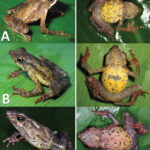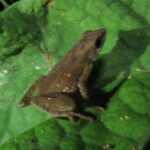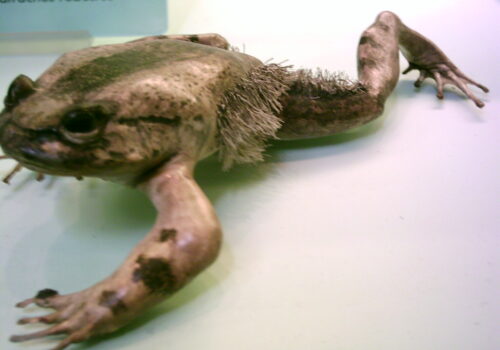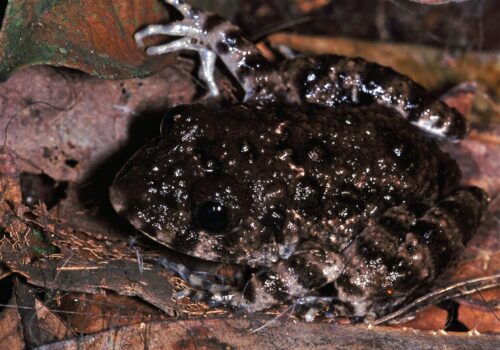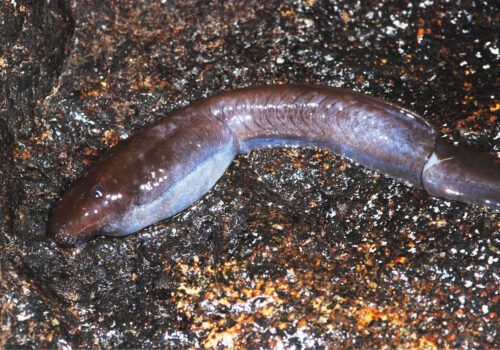- Leptopelis fenestratus: The Enchanting Forest Tree Frog of East Africa
Leptopelis fenestratus: The Enchanting Forest Tree Frog of East Africa#
In the lush, humid forests of East Africa, amid tangled vines and vibrant greenery, lives a captivating amphibian whose melodious call signals twilight’s arrival. It is here, under the deep canopies and within dense foliage, that the Leptopelis fenestratus—a charming arboreal frog commonly known as the Forest Tree Frog or the Web-eyed Tree Frog—makes its home. With shimmering skin and a melodious trill that echoes softly through the twilight, this frog has captured the imagination of naturalists, researchers, and conservationists alike.
Belonging to the family Arthroleptidae, the scientific name Leptopelis fenestratus hints at the intricate beauty of this small amphibian—derived from Latin, “fenestratus” means “provided with windows,” an imaginative reference to its remarkable eyes. As a significant member of its ecosystem, this enchanting tree frog plays essential roles that ripple far beyond the delicate leaves it perches upon.
Taxonomy and Classification#
The Forest Tree Frog, scientifically classified as Leptopelis fenestratus, belongs to the family Arthroleptidae, a group known for their diversity and adaptation to various ecological niches in sub-Saharan Africa. The genus Leptopelis comprises tree-frogs characterized by distinctively large eyes, effective camouflage, and versatile climbing capabilities.
Within its genus, the species fenestratus shares many similarities with other tree-dwelling amphibians. However, subtle variations in coloration, vocalizations, and habitat preferences set it apart. Researchers frequently focus on these frogs to understand evolutionary traits among amphibians, as well as the adaptive significance behind their wide, brilliantly reflective eyes—aptly earning their common nickname, “Web-eyed Tree Frog.”
Natural Habitat#
Geographic Range and Preferred Environment#
Leptopelis fenestratus thrives predominantly along the coastal forests of Tanzania and Mozambique, extending inland to the verdant resplendence of Malawi and parts of Zimbabwe. Its range spreads across regions where the tropical woodland habitats transition to dense, ever-green forests blanketed with moisture and resonant with wildlife’s symphony. These habitats provide ideal conditions: abundant rainfall, moderate temperatures, bountiful food sources, and plentiful hiding spots amid dense vegetation.
Amongst the tangled vegetation, near gently flowing streams or marsh edges, this arboreal frog selects perching areas strategically—often close to tranquil water bodies vital for tadpole development. Seeking humid microhabitats, they reside in habitats with intact forest canopies, extensive understory plants, and occasional open clearings which allow their enchanting calls to echo clearly during mating rituals.
Adaptations to a Tree-Dwelling Lifestyle#
The arboreal lifestyle of Leptopelis fenestratus necessitates various remarkable adaptations. Exceptional gripping pads on each toe provide exceptional adhesion to slippery leaves and branches, allowing effortless maneuverability high above the forest floor. Their large eyes grant impressive nocturnal vision, essential for locating prey and navigating the dense, shadowy landscape of forest canopies beneath subdued moonlight.
These frogs display remarkable resilience—capable of thriving through seasonal shifts in moisture. In dryer periods, they seek refuge in damp, shaded vegetation niches, emerging with refreshingly enhanced vigor when returned rains rehydrate their lush habitats.
Physical Characteristics#
Though modestly sized, measuring typically between 30 to 55 mm, Leptopelis fenestratus captivates those fortunate enough to encounter one through its graceful appearance and exquisite coloration. Their compact bodies exhibit a slender design adapted seamlessly to perch on vegetation, combined with hind limbs designed for agile jumps and swift climbing.
The species possesses genuinely mesmerizing eyes: strikingly large, bulbous, and reflective, rendering a true sense of intrigue and wonder. Their brilliant irises feature intricate patterns and captivating shades ranging from mottled gold and copper-brown to silvery-green hues, encased perfectly in black-pupilled windows.
A jewel-toned epidermis colors the smooth texture of this delightful frog, displaying shades that resonate with their forest habitat—a harmonious blend of pale greens, coppery browns, golden yellows, or marbled greys, accentuated by darker mottling or subtle veins. Each individual displaying subtle variations helps camouflage efficiently within their verdurous surroundings—crucially aiding their stealthy hunting style and protection from predators.
Behavior and Life Cycle#
Nocturnal Predators of the Forest Canopy#
Displaying mainly nocturnal habits, Leptopelis fenestratus emerges from day shelters hidden amidst thick foliage only under the cover of dusk. When darkness envelops the forest, a symphony of frog chorus resonates through the air, a distinctive melodious croaking signaling its evening endeavors. Active hunters, these frogs primarily consume invertebrates—devouring moths, beetles, crickets, spiders, and other small insects that venture within their striking range.
Utilizing stealth, combined with lightning-fast reactions, they rely on ambush predation. Their sharp, projectile tongues capture prey with remarkable accuracy, making them formidable hunters in the micro-world of insects.
An Intricate Mating Ritual#
As seasons shift, warmer rains invigorate these delicate amphibians, marking prolonged, mesmerizing mating performances. Males assemble near tranquil water sources and produce delightful calls—rich, resonant chirps and whistles—to entice receptive females. These choruses ripple softly through the forest nights, creating an ethereal acoustic tapestry distinctive to this species.
During these mating rituals, rivalry behaviors remain mostly acoustical rather than physical, with rival males competing through elaborate vocal displays rather than direct confrontation. Females, guided by these intricate choruses, select mates carefully, often choosing individuals with the loudest and healthiest vocalizations—traits indicating robust genetic fitness.
Tadpole Development and Growth#
Females deposit clusters of translucent eggs upon submerged vegetation or branches hanging gently above quiet pools or shallow ponds. Initial stage life teems silently in these limpid waters, with tadpoles developing while feasting on algae, detritus, and microscopic organisms. Throughout their aquatic adolescence, these tadpoles undergo dramatic morphological transformations, gradually sprouting limbs, losing tails, and eventually emerging onto terrestrial foliage as young froglets.
Like their forebears, these fascinating juveniles ascend into higher vegetation seeking ideal conditions to establish territories and adapt swiftly to life suspended among tree branches.
Ecological Role of Leptopelis fenestratus#
Though small, Leptopelis fenestratus fulfills multiple crucial ecological roles within its habitat, maintaining the equilibrium and health of forest environments. By consuming abundant insects and arthropods, it controls populations of potential pests, harmonizing ecological balances vital for flourishing vegetation and other wildlife.
Equally significant, this tree frog provides nourishment to a diverse array of predators. Birds such as owls and snake species endemic to East African forests heavily depend on amphibians as prey, thus shaping intricate predator-prey dynamics integral to a sustainable ecological structure.
Furthermore, amphibians often serve as crucial indicator species, sensitive to environmental changes and indicating ecosystem health. Fluctuations in population size or health offer early warnings regarding cumulative threats such as habitat degradation, pollution, and climate disruptions—emphasizing their role in ecological monitoring.
Threats and Conservation Status#
Currently classified as Least Concern by the IUCN, these resilient creatures inhabit extensive regions experiencing frequent habitat disruptions like deforestation, agricultural expansion, and climate-driven rainfall variability. Fragmentation poses additional challenges, disrupting migration corridors and isolating local populations, ultimately reducing genetic diversity and adaptability.
Moreover, global issues like climate change increasingly threaten their forest habitats by excessively drying critical breeding ponds and causing irregular rainfall patterns—factors potentially detrimental to breeding success.
Cultural and Scientific Significance#
Across East Africa’s enchanting forests, tree frogs, including Leptopelis fenestratus, hold cultural significance in folklore, symbolizing renewal and hope due to their life cycle transformations—from aquatic larvae to canopy-coming adults. Scientifically, ongoing studies focus extensively, using Leptopelis species for valuable insights regarding toxin research, evolutionary biology, and environmental indicators—assisting conservationists in protecting vital ecosystems worldwide.
Conclusion: Preserving the Forest Chorus#
As twilight descends upon East Africa’s forests, the melodious song and ascendant climbing of Leptopelis fenestratus symbolizes harmony within delicate habitats shared with countless creatures. Cherishing each frog means protecting interconnected ecosystems they symbolize, emphasizing conservation’s vitality. Amphibian conservation sparks collective passion, urging us toward action—declaring our steadfast guardianship over mesmerizing biodiversity present within Earth’s wondrous living tapestry.
Join in the preservation journey—educate, engage community voices, support conservation leaders. Together, let’s preserve the enchanting chorus haunting these forests, securing futures rich with vibrant wildlife and melodious beauty.


